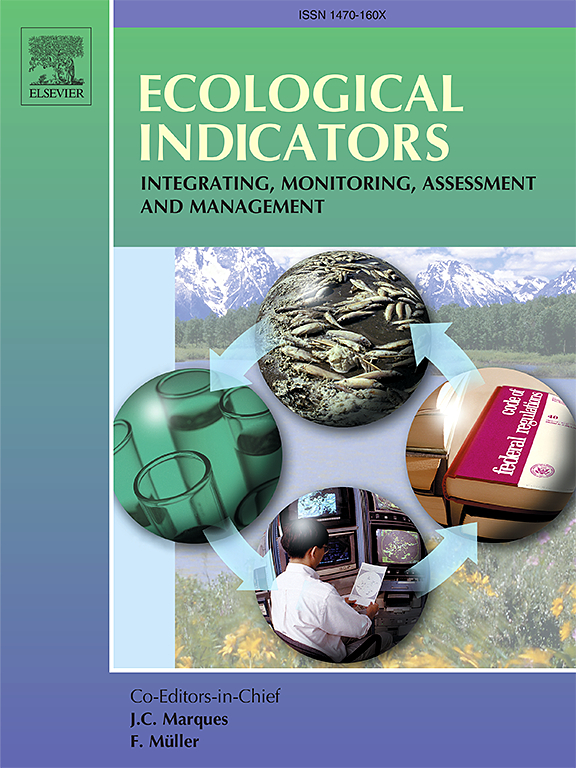Assembly, network stability, and dominant function of bacterial communities in different habitats of a large shallow lake: The role of habitat generalists
IF 7
2区 环境科学与生态学
Q1 ENVIRONMENTAL SCIENCES
引用次数: 0
Abstract
Microbial communities are fundamental drivers of biogeochemical processes within various habitats of lake ecosystems. While differences in bacterial community composition among habitats have been well documented, our knowledge about the roles of different groups of microbes in maintaining the diversity patterns remains limited. In this study, we investigated the diversity patterns and functional roles of bacterial communities and sub-communities (habitat generalists and habitat specialists) across different habitats (water column, suspended particles, and sediments) of a large, shallow freshwater lake, Taihu. Our results revealed distinct patterns in alpha diversity and pairwise dissimilarity among habitats. The sediment bacterial community exhibited the highest alpha diversity, whereas the particle-attached bacterial community showed the greatest pairwise dissimilarity. Community assembly processes varied among the three habitats: deterministic processes dominated in the sediment bacterial community, while stochastic processes prevailed in the free-living community. The stability and complexity of habitat networks followed similar patterns, with the sediment bacterial network being the most complex and stable, while the particle-attached bacterial network was the simplest and most fragile. We identified sub-communities, including habitat generalists and specialists, and compared their network roles across habitats. A higher number of core network nodes and betweenness centrality of habitat generalists were observed across different networks in comparison with specialists, highlighting the crucial role of generalists in stabilizing the habitat microbial communities. The dominant function of the habitat generalists, chemoheterotrophy, was positively associated with the network cohesion of different habitats, supporting the roles of the generalists in maintaining the stability of the community. This study provides new insights into microbial community assembly in lake ecosystems and highlights the critical roles of habitat generalists in maintaining bacterial network stability.

大型浅湖不同生境中细菌群落的聚集、网络稳定性和优势功能:生境通才的作用
微生物群落是湖泊生态系统各种生境中生物地球化学过程的基本驱动力。虽然不同生境中细菌群落组成的差异已经被很好地记录下来,但我们对不同微生物群在维持多样性模式中的作用的了解仍然有限。本文研究了太湖浅水湖不同生境(水柱、悬浮颗粒和沉积物)中细菌群落和亚群落(生境通才和生境专才)的多样性格局和功能作用。结果表明,不同生境的α多样性和两两差异具有明显的规律。沉积物细菌群落的α多样性最高,而颗粒附着细菌群落的α差异最大。群落组装过程在三种生境中存在差异:确定性过程在沉积物细菌群落中占主导地位,而随机过程在自由生活群落中占主导地位。生境网络的稳定性和复杂性具有相似的规律,沉积物细菌网络最复杂、最稳定,颗粒附着细菌网络最简单、最脆弱。我们确定了亚群落,包括生境通才和专家,并比较了他们在生境中的网络角色。在不同的网络中,通才型的核心网络节点数量和中间性中心性均高于专才型,说明通才型在稳定生境微生物群落中的重要作用。生境通才的优势功能——趋化异养与不同生境的网络凝聚力正相关,支持通才在维持群落稳定中的作用。该研究为湖泊生态系统微生物群落的组成提供了新的见解,并强调了生境通才在维持细菌网络稳定性中的重要作用。
本文章由计算机程序翻译,如有差异,请以英文原文为准。
求助全文
约1分钟内获得全文
求助全文
来源期刊

Ecological Indicators
环境科学-环境科学
CiteScore
11.80
自引率
8.70%
发文量
1163
审稿时长
78 days
期刊介绍:
The ultimate aim of Ecological Indicators is to integrate the monitoring and assessment of ecological and environmental indicators with management practices. The journal provides a forum for the discussion of the applied scientific development and review of traditional indicator approaches as well as for theoretical, modelling and quantitative applications such as index development. Research into the following areas will be published.
• All aspects of ecological and environmental indicators and indices.
• New indicators, and new approaches and methods for indicator development, testing and use.
• Development and modelling of indices, e.g. application of indicator suites across multiple scales and resources.
• Analysis and research of resource, system- and scale-specific indicators.
• Methods for integration of social and other valuation metrics for the production of scientifically rigorous and politically-relevant assessments using indicator-based monitoring and assessment programs.
• How research indicators can be transformed into direct application for management purposes.
• Broader assessment objectives and methods, e.g. biodiversity, biological integrity, and sustainability, through the use of indicators.
• Resource-specific indicators such as landscape, agroecosystems, forests, wetlands, etc.
 求助内容:
求助内容: 应助结果提醒方式:
应助结果提醒方式:


